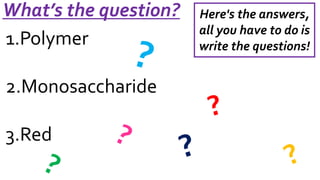
AS-U1-2.3 Carbohydrates-disaccharides and polysaccharides
- 1. What’s the question? 1.Polymer 2.Monosaccharide 3.Red Here's the answers, all you have to do is write the questions!
- 2. Carbohydrates- Polysaccharides Objective: To understand how monosaccharides form polysaccharides. Outcomes: ~ Describe what a disaccharide is and name examples. ~ Explain how monosaccharides are linked to form polysaccharides. ~ Explain how to carry out a test for non-reducing sugars and for starch. Sunday, 28 September 2014 Keywords Disaccharide Polysaccharide Condensation reaction Glycosidic bond Hydrolysis
- 3. Disaccharides Monosaccharide + monosaccharide = disaccharide Monosaccharide Monosaccharide Disaccharide Glucose Glucose Maltose Glucose Fructose Sucrose Glucose Galactose Lactose
- 4. How? glucose + glucose maltose + water Glycosidic bond Condensation reaction
- 5. Test for non-reducing sugars (Sucrose) 1.Confirm that the sample you’re testing is not a reducing sugar. 2.Add 2cm3 of food sample (liquid form) to 2cm3 of dilute hydrochloric acid and place in a gently boiling water bath for 5mins. 3.Slowly add sodium hydrogen carbonate solution. Check the solution is then neutral. 4.Re-test this solution now again with Benedict’s.
- 6. Test for non-reducing sugars (Sucrose) Hydrochloric acid is added to the sample because… Sodium hydrogencarbonate is added because… If a non-reducing sugar is present, the Benedict’s reagent will now turn red because…
- 7. Polysaccharides Polymers. Large molecules yet compact. Insoluble. e.g. Starch Hydrolysed into glucose. Starch granules in plant cells
- 8. e.g. Cellulose Provides structural support in plant cells.
- 9. Test for starch 1.Add two drops of sample onto a spotting tile. 2.Add two drops of potassium iodide. 3.Starch indicated by blue-black result.
- 10. 2.3 Carbohydrates-disaccharides and polysaccharides Forming and breaking glycosidic bonds Complete the diagrams below to show how glycosidic bonds can be formed and broken. This type of reaction is called a… The molecule formed is… This type of reaction is called a… The molecules formed are…
Notas do Editor
- e.g Sucrose. Recap Benedict’s test and highlight neutralisation.
